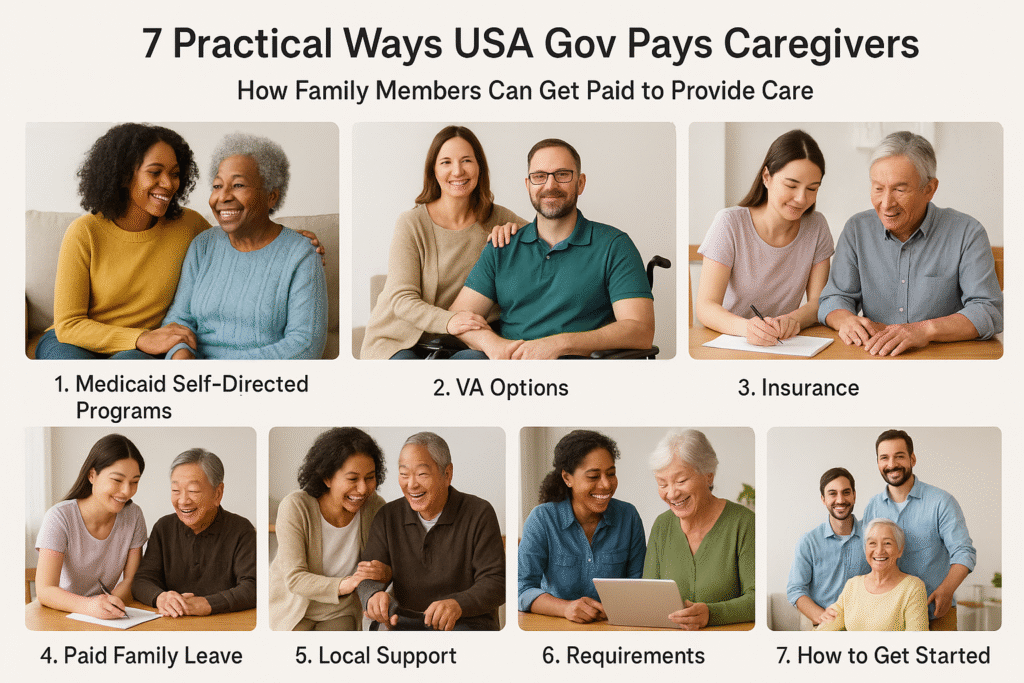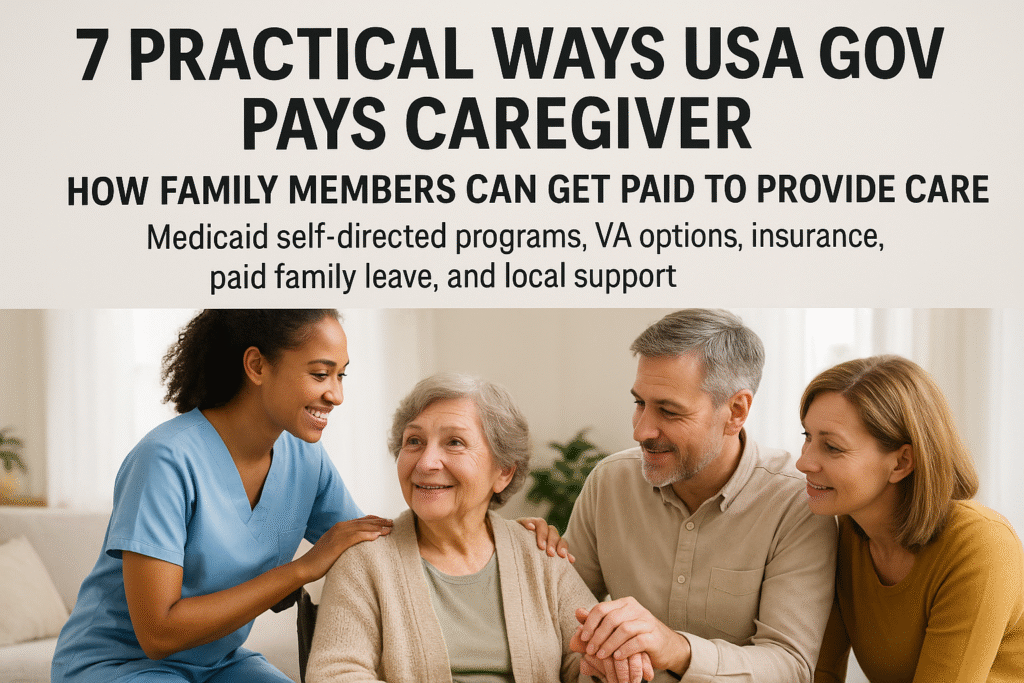USA Gov Pays Caregiver : Caring for a family member is an act of love — and in many cases, it can be paid work. This friendly, step-by-step guide explains the main ways family members or friends can be paid to provide care (Medicaid self-directed programs, VA options, insurance, paid family leave, and local support), what each path requires, and exactly how to get started. All links and facts below are drawn from official government sources.
Quick snapshot — the 7 ways to get paid as a caregiver
- State Medicaid consumer-directed / self-directed programs (most common). (Medicaid)
- VA Veteran-Directed Care and VA caregiver supports (for veterans). (Veterans Affairs, Caregiver VA)
- Aid & Attendance (VA pension enhancement that helps pay for caregiving). (Veterans Affairs)
- Long-term care insurance policies that allow family caregivers. (USAGov)
- State paid family leave programs that sometimes pay when you care for a family member. (USAGov)
- Local programs and Area Agencies on Aging (AAA) referrals for respite and support. (ACL Administration for Community Living, eldercare.acl.gov)
- Other agency-specific programs or grants (varies by state and veteran status). (Medicaid)
Below is a clear, practical path you can follow depending on who you care for (Medicaid recipient, veteran, privately insured person, or someone without coverage).
Step 1 — Is the person you care for on Medicaid? Start here
If the person you care for already receives Medicaid, many states let that person hire a family member or friend as a paid caregiver through a consumer-directed personal assistance model (also called self-directed services). Under this model the Medicaid participant (or their representative) hires, trains, and supervises caregivers and can set schedules or hours. Rules, pay rates, and eligibility vary by state, so the first step is to contact your state Medicaid office.
What to ask your state Medicaid office:
- Do you offer consumer-directed / self-directed personal assistance programs? (Some use 1915(c), 1915(j), or state plan options.)
- What are the caregiver hiring rules (criminal checks, minimum age, training)?
- What is the pay rate and how are timesheets submitted and approved?
- Who is the fiscal/employer agent (some states use a fiscal intermediary to handle payroll)?
Quick next step: call the Medicaid contact listed on the Medicaid.gov “Where can people get help?” page for your state.
Step 2 — Caring for a veteran? Explore VA-specific programs
If the person you care for is a veteran, the VA offers several clear options that may let a family member be paid:
- Veteran-Directed Care (VDC) gives veterans a flexible budget they can use to hire caregivers — including family — for help with daily activities. VDC is consumer-directed and meant to help veterans remain in their homes.
- VA Respite Care supports family caregivers by funding short-term professional respite so caregivers can rest; some respite arrangements include hiring temporary paid help.
- Aid & Attendance (A&A) is a pension benefit that increases monthly VA pension amounts for veterans/survivors who need a caregiver; those funds can be used to pay for care (including family caregivers). Check VA eligibility and pension rates.
How to start: contact your local VA Geriatrics & Extended Care office or VA pension management center and ask about Veteran-Directed Care, respite options, and whether Aid & Attendance applies. Find local VA contact info on VA.gov.

Step 3 — If Medicaid or VA don’t apply, check long-term care insurance
Some long-term care insurance policies allow insured people to hire family members as paid caregivers or pay an allowance that can be used for family care. If the person you care for has long-term care insurance:
- Contact the insurer or agent and request written confirmation of policy benefits and whether family caregivers are eligible to be paid.
- Ask what documentation is needed (care plan, hours, receipts).
Tip: get any insurer answers in writing and keep detailed timesheets and care plans to support claims.
Step 4 — Paid family leave — a state option for short-term care
Several states and territories offer paid family leave (PFL) programs that pay wages while you care for a covered family member for a limited time. These programs vary by state in:
- Who qualifies,
- How much they pay, and
- How long you can take leave.
If your employer is covered by a state PFL program (or your state mandates paid leave), you may be eligible for wage replacement while providing care. Contact your state labor office or check the USA.gov guidance for links to your state’s program.
Step 5 — Local help: Area Agencies on Aging, Eldercare Locator & community resources
Area Agencies on Aging (AAAs) and the federal Eldercare Locator are excellent local connectors if you need:
- Counseling and caregiver training,
- Respite programs, adult day services, or meal deliveries,
- Referrals to local providers who can supplement family care.
Search by ZIP code at the Eldercare Locator or contact your local AAA for the menu of local supports — they can also point you to state programs you might miss.
Step 6 — Paperwork, payroll, and legal considerations
If you or your family member plan to set up paid caregiving, get these basics in place:
- Employer of record / fiscal intermediary: Many Medicaid and VA programs require using a fiscal agent to handle background checks, payroll taxes, and timesheets. Ask your program which agency manages payroll.
- Timesheets & care plans: Keep accurate, signed timesheets and a written care plan (who does what, when). These documents are often required for payment.
- Tax and benefits impact: Paid caregiving income may affect taxes and benefit eligibility — consider consulting a tax advisor.
- Background checks & training: Some states require criminal background checks, training, or competency checks for paid caregivers. Confirm state rules before you start working.
Practical sample checklist (use when you call an agency): name of the care recipient, program (Medicaid / VDC / A&A / insurance), your relationship, preferred start date, and a request for written hiring/payment rules.

Step 7 — If you hit a roadblock: who to call next
- Medicaid questions: Contact your state Medicaid office (Medicaid.gov lists state contacts).
- VA questions: Contact your local VA medical center (Geriatrics & Extended Care) or the VA pension center for Aid & Attendance.
- Local services: Call the Eldercare Locator at 1-800-677-1116 for local AAAs and resources.
Real-world example — how a family caregiver gets paid (typical flow)
- Person A receives Medicaid and qualifies for a self-directed program.
- Person A (or their representative) chooses a fiscal intermediary and lists a family member as the personal assistant.
- The family caregiver completes required paperwork, background checks, and training.
- Caregiver submits timesheets; the fiscal agent processes payroll and issues paychecks.
- Family keeps copies of timesheets, care plan, and payments for tax and benefits records.
Quick FAQ
Q: Does every state let you get paid as a family caregiver through Medicaid?
A: Many states offer self-directed Medicaid options, but participation rules and pay rates vary. Contact your state Medicaid office to confirm.
Q: Can veterans hire family members and get paid?
A: Yes—Veteran-Directed Care and some VA programs support hiring family caregivers. Aid & Attendance can also increase pension payments to cover caregiving costs. Check VA pages for eligibility.
Q: Will being paid affect my taxes or the recipient’s benefits?
A: Paid caregiving income may affect taxes and the care recipient’s benefits (depending on the program). Keep records and consult a tax or benefits counselor.
Final checklist — call this week
- If care recipient is on Medicaid: call your state Medicaid office and ask about consumer-directed programs.
- If care recipient is a veteran: contact your local VA Geriatrics & Extended Care and the VA pension center.
- If private insurance exists: request written confirmation from the insurer about paid family caregiving provisions.
- If you need local supports: call the Eldercare Locator at 1-800-677-1116 or visit eldercare.acl.gov.
Disclaimer: This article is informational and not legal, tax, or medical advice. Program rules, payment amounts, and eligibility change by state and over time. Always confirm details with your state Medicaid office, VA office, insurer, or local Area Agency on Aging before taking action. Official government pages linked below are authoritative. Images used in this article are royalty‑free or licensed for commercial use and are provided here for illustrative purposes.
Helpful official links (clickable)
- Get paid as a caregiver for a family member — USA.gov (overview & links). (USAGov)
https://www.usa.gov/disability-caregiver - Self-Directed / Self-Directed Services — Medicaid.gov (how states run consumer-directed programs). (Medicaid)
https://www.medicaid.gov/medicaid/long-term-services-supports/self-directed-services - Veteran-Directed Care — VA (Geriatrics & Extended Care). (Veterans Affairs)
https://www.va.gov/geriatrics/pages/Veteran-Directed_Care.asp - VA Aid & Attendance and Housebound benefits — VA. (Veterans Affairs)
https://www.va.gov/pension/aid-attendance-housebound/ - Eldercare Locator (find your local Area Agency on Aging) — ACL / Eldercare Locator. (eldercare.acl.gov)
https://eldercare.acl.gov - Where to get help with Medicaid & CHIP — Medicaid.gov (state contact list). (Medicaid)
